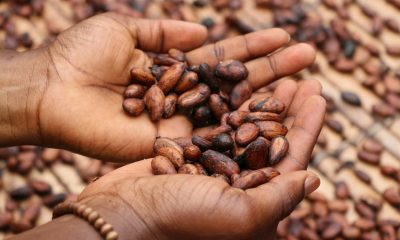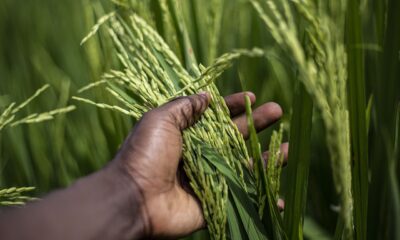Featured
Some commodities markets locked in a sideways trend
Palm Oil closed lower last week on weakness in other oilseeds. Ideas of tight supplies are still around but supplies should start to seasonally increase. Private sources reported a solid export pace so far this month. The production of Palm Oil is down in both Malaysia and Indonesia as plantations in both countries are having trouble getting workers into the fields.

Wheat: Winter Wheat markets were mixed on Friday but lower for the week. Trends are down on the daily and the weekly charts for all three markets. Speculators appeared to be the best sellers and sold on reports of some rains in Texas and a stronger US Dollar. Demand has been disappointing so far as traders had expected better exports due to problems in Russia and parts of Europe earlier in the year. Ideas are that rain that is falling in the Great Plains will help injured Winter Wheat. Temperatures dropped below 0F in many areas a few weeks ago and that is cold enough to kill an unprotected crop. The actual damage will take some time to see under warmer temperatures and it might take until harvest to see the full effects of the recent extreme cold.
Weekly Chicago Soft Red Winter Wheat Futures

Weekly Chicago Hard Red Winter Wheat Futures

Weekly Minneapolis Hard Red Spring Wheat Futures

Corn: Corn closed higher in recovery trading and remains locked in a sideways trend on both the daily and weekly charts. Oats reversed last week and now appear ready to drift higher. Traders are still concerned that China might not buy more US Corn because the talks over the previous weekend between China and the US were not really positive. The country bought about 4.0 million tons of US Corn in the export sales report last week, but the report showed less sold to other destinations. Chinese demand had been strong until recently and it looks like they need the Corn. Prices inside China for Corn remain extremely high. It is still raining but is drier in central and parts of northern Brazil, and farmers are able to harvest much of the Soybeans area and plant much of the Winter Corn. The Winter Corn crop is on a very slow pace to be planted and progress is well behind normal. Argentina has seen a general rain in the last week and Corn in Argentina has stabilized after losing yield to dry conditions and crop stress. Southern Brazil is also in a better place on crop conditions. More rain is in the forecast for these areas in the next week. The main crop harvest has started in parts of Brazil, but progress will be slow due to the late planting dates due to dry conditions earlier in the year.
Weekly Corn Futures:

Weekly Oats Futures

Soybeans and Soybean Meal: Soybeans and Soybean Oil closed lower on reports that Argentine Soybean Oil was on its way here. Reports on Twitter indicate that up to two shipments of Soybean Oil are on the way. Soybean Meal closed a little higher on spreads against Soybean Oil. Selling came on ideas that the ongoing Brazil harvest will kill the current demand for US Soybeans. Demand was worse at just over 100,000 tons for Soybeans last week in the weekly export data but the US has now sold 99% of its target amount of Soybeans for the marketing year and really has very few Soybeans left to sell. The Brazil harvest had been delayed due to late planting dates early due to dry weather and now too much rain that has caused harvest delays and some quality problems in the north as well. Harvest activities have increased but the harvest remains very slow overall. China has been buying for this year and next year here but now mostly in South America. US internal demand has also been strong.
Weekly Chicago Soybeans Futures:

Weekly Chicago Soybean Meal Futures

Rice: Rice was lower again on Friday and lower for the week on what appeared to be speculative selling against commercial buying. The export sales report was strong but half of the previous volume. The cash market has not felt any increased export demand lately and mill operations are reported to be on the slow side. Texas is about out of Rice, but there is Rice available in the other states, especially Arkansas. Asian and Mercosur markets were steady to firm last week. New crop Rice is getting planted in Texas and planting is up to half done in Louisiana. Mississippi is about to start.
Weekly Chicago Rice Futures

Palm Oil and Vegetable Oils: Palm Oil closed lower last week on weakness in other oilseeds. Ideas of tight supplies are still around but supplies should start to seasonally increase. Private sources reported a solid export pace so far this month. The production of Palm Oil is down in both Malaysia and Indonesia as plantations in both countries are having trouble getting workers into the fields. Wet weather has caused even more delays. The weather is improved and trees seasonally increase production about now. Canola was lower on what appeared to be speculative selling tied to price action in Chicago. There were reports that the US was about to import a couple of cargoes of Soybean Oil from Argentina to break prices in both Soybean Oil and Canola. Worries about South American production are supporting both markets but the weather is better now and both are looking for new triggers to promote more buying.
Weekly Malaysian Palm Oil Futures:

Weekly Chicago Soybean Oil Futures

Weekly Canola Futures:

Cotton: Futures were lower on speculative selling tied to demand fears due to the potential return on the Coronavirus and a much stronger US Dollar. The weekly export sales report was strong, but not nearly as strong as the previous week. Rains in Texas were negative for prices as well. The trends turned down on the weekly charts due to the price action of last week. The chart trends are down on the daily charts. The demand for US Cotton in the export market has been strong even with the Coronavirus and the strong demand could continue as USDA also cut Brazil production due to reduced planted area this year. The US stock market has been generally firm to help support ideas of a better economy here and potentially increased demand for Cotton products.
Weekly US Cotton Futures

Frozen Concentrated Orange Juice and Citrus: FCOJ closed a little higher and the trends are now sideways on the daily charts. Support is showing at current price levels as futures do not appear ready to make new lows on the daily charts. The demand for FCOJ is said to be weaker as the Coronavirus has been less in the US. The weather has turned warmer so less flu is around as well. Moderate temperatures are expected for Florida this week. The weather in Florida is good with a few showers or dry weather to promote good tree health and fruit formation. Showers have fallen in Brazil, but it is dry now and crop conditions are called good even with drier than normal soils. Stress to trees could return if the dry weather continues. Mexican crop conditions in central and southern areas are called good with rains, but earlier dry weather might have hurt production. It is dry in northern and western Mexican growing areas.
Weekly FCOJ Futures

Coffee: Futures were higher in both markets on Friday and higher for the week. Selling came on what appeared to be fund and other speculator selling due to a stronger US Dollar. Commercials and some speculators could have been the buyers. Cash market buyers are not buying much Coffee but offers are not strong from many origins. Vietnam producers are selling some Coffee. There are reports of good weather in Vietnam for the harvest. Indonesia has had good weather but has little coffee to sell now. Dry conditions are reported in Brazil again but crop conditions are still good. Trees might get stressed again in the dry weather continues for several more days. Central America is also drier for harvesting but production might have been reduced due to very wet conditions during the growing season. Good growing conditions are reported in Colombia and Peru. Africa is also noting good growing conditions.
Weekly New York Arabica Coffee Futures

Weekly London Robusta Coffee Futures

Sugar: New York and London closed lower on the stronger US Dollar and increased Brazilian Sugar production at the expense of Ethanol. The chart trends are still mostly down on the daily and the weekly charts. The market appears to be searching for a new source of demand as current demand is called average. Dry conditions were reported in Brazil. It has been raining in south-central Brazil and the production of cane is looking good for the next harvest. Production has been hurt due to dry weather earlier in the year and this week could be dry again. Traders are worried about a delayed Brazil harvest and lack of space at Brazil ports for Sugar shipments due to the high Soybeans shipments and delayed nature of the harvest of the Soybeans. India is exporting Sugar and is reported to have a big cane crop this year.
Weekly New York World Raw Sugar Futures

Weekly London White Sugar Futures

Cocoa: Both markets closed a little lower. Chart trends are turning down again on the daily charts and are down on the weekly charts. The main crop harvest has started in Nigeria and will soon spread to Ivory Coast and Ghana. Demand should improve as the Covid vaccinations get administered and as at least some governments around the world invest in fiscal stimulus on their economies. Fears of a Coronavirus resurgence are hurting demand ideas. Production appears to be good this year and the supply surplus is growing.
Weekly New York Cocoa Futures

Weekly London Cocoa Futures

—
(Featured image by Free-Photos via Pixabay)
DISCLAIMER: This article was written by a third-party contributor and does not reflect the opinion of Born2Invest, its management, staff or its associates. Please review our disclaimer for more information.
This article may include forward-looking statements. These forward-looking statements generally are identified by the words “believe,” “project,” “estimate,” “become,” “plan,” “will,” and similar expressions. These forward-looking statements involve known and unknown risks as well as uncertainties, including those discussed in the following cautionary statements and elsewhere in this article and on this site. Although the Company may believe that its expectations are based on reasonable assumptions, the actual results that the Company may achieve may differ materially from any forward-looking statements, which reflect the opinions of the management of the Company only as of the date hereof. Additionally, please make sure to read these important disclosures.
Futures and options trading involves substantial risk of loss and may not be suitable for everyone. The valuation of futures and options may fluctuate and as a result, clients may lose more than their original investment. In no event should the content of this website be construed as an express or implied promise, guarantee, or implication by or from The PRICE Futures Group, Inc. that you will profit or that losses can or will be limited whatsoever. Past performance is not indicative of future results. Information provided on this report is intended solely for informative purpose and is obtained from sources believed to be reliable. No guarantee of any kind is implied or possible where projections of future conditions are attempted. The leverage created by trading on margin can work against you as well as for you, and losses can exceed your entire investment. Before opening an account and trading, you should seek advice from your advisors as appropriate to ensure that you understand the risks and can withstand the losses.

-

 Crypto2 weeks ago
Crypto2 weeks agoCaution Prevails as Bitcoin Nears All-Time High
-

 Africa6 days ago
Africa6 days agoBridging Africa’s Climate Finance Gap: A Roadmap for Green Transformation
-

 Biotech2 weeks ago
Biotech2 weeks agoEcnoglutide Shows Promise as Next-Generation Obesity Treatment
-

 Business4 days ago
Business4 days agoThe TopRanked.io Weekly Digest: What’s Hot in Affiliate Marketing [uMobix Affiliate Program Review]























